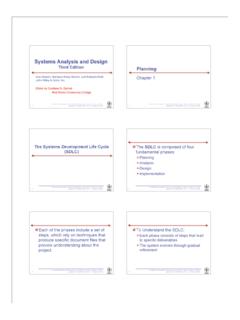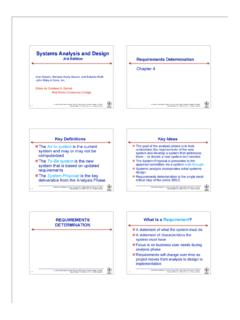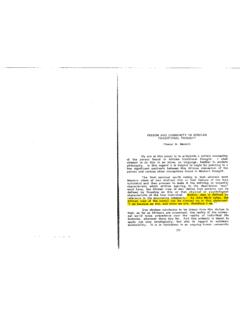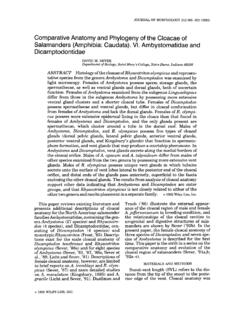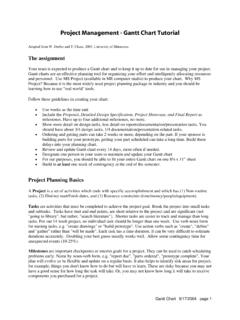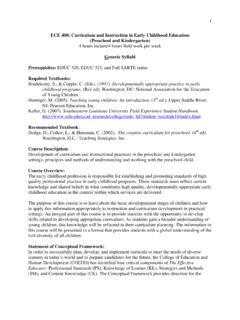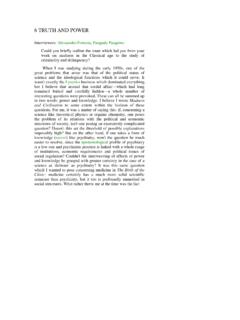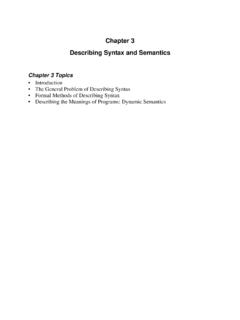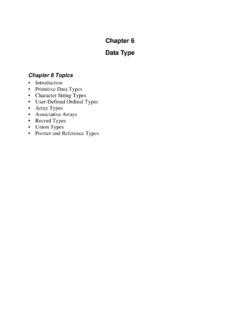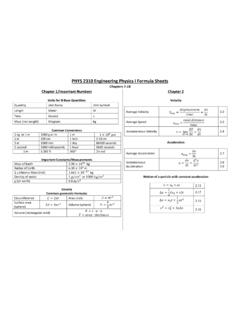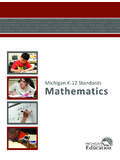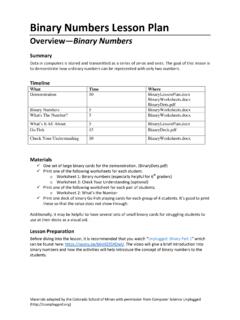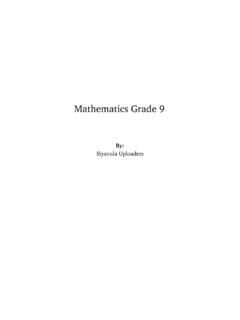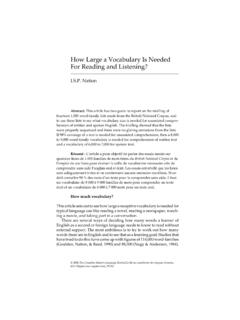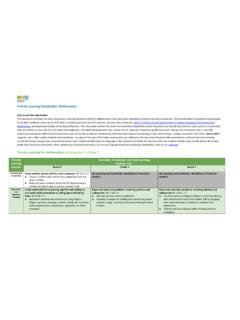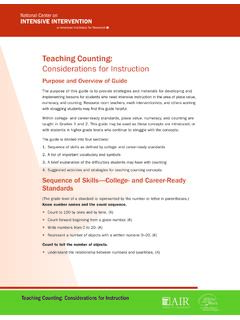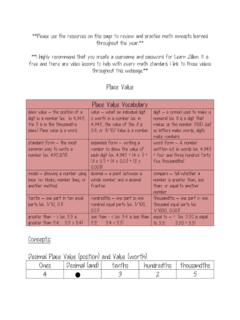Transcription of CHAPTER 2 Instructions: Language of the Computer
1 CMPS290 Class Notes (Chap02) Page 1 / 45 by Kuo-pao Yang CHAPTER 2 instructions : Language of the Computer Introduction 62 Operations of the Computer Hardware 63 Operands of the Computer Hardware 66 Signed and Unsigned Numbers 73 Representing instructions in the Computer 80 Logical Operations 87 instructions for Making Decisions 90 Supporting Procedures in Computer Hardware 96 Communicating with People 106 MIPS Addressing for 32-Bit Immediates and Addresses 111 Parallelism and instructions : Synchronization 121 Translating and Starting a Program 123 A C Sort Example to Put It All Together 132 Arrays versus Pointers 141 Advanced Material: Compiling C and Interpreting Java 145 Real Stuff: ARM v7 (32-bit) instructions 145 Real Stuff: x86 instructions 149 Real Stuff.
2 ARM v8 (64-bit) instructions 158 Fallacies and Pitfalls 159 Concluding Remarks 161 Historical Perspective and Further Reading 163 Exercises 164 CMPS290 Class Notes (Chap02) Page 2 / 45 by Kuo-pao Yang Introduction 62 Instruction Set o To command a Computer s hardware, you must speak its Language . The words of a Computer s Language are called instructions , and its vocabulary is called instruction set. o Different computers have different instruction sets Operations of the Computer Hardware 63 FIGURE MIPS assembly Language revealed in this CHAPTER .
3 CMPS290 Class Notes (Chap02) Page 3 / 45 by Kuo-pao Yang Operands of the Computer Hardware 66 Unlike programs in high-level languages, the operands of arithmetic instructions are restricted; they must be from a limited number of special locations built directly in hardware called registers. Arithmetic instructions use register operands. o Word: The natural unit of access in a Computer , usually a group of 32 bits; corresponds to the size of a register in the MIPS architecture. 32-bit data called a word One major difference between the variables of a programming languages and registers is the limited number of register, typically 32 on current computers, like MIPS.
4 MIPS has a 32 32-bit register file o The size of a register in the MIPS architecture is 32 bits. o Numbered 0 to 31: $0, $1, .. $31 o Assembler names $t0, $t1, .., $t9 for temporary values $s0, $s1, .., $s7 for saved variables Example: Compiling a C Assignment using Registers o C code: f = (g + h) - (i + j); The variables f, g, h, i, and j are assigned to the register in $s0, $s1, $s2, $s3, and $s4, respectively. What is the compiled MIPS code? o Compiled MIPS code: add $t0, $s1, $s2 #$t0 contains g + h add $t1, $s3, $s4 #$t1 contains i + j sub $s0, $t0, $t1 # f get $t0 - $t1, which is (g + h) (i + j) Memory Operands Data transfer instruction: A command that moves data between memory and registers Address: A value used to delineate the location of a specific data element within a memory array.
5 To access a word in memory, the instruction must supply the memory address. Memory is just a large, single-dimensional array, with the address acting as the index to that array, starting at 0. Memory is byte addressed: each address identifies an 8-bit byte. The data transfer instruction that copies data from memory to a register is traditionally called load. The actual MIPS name for this instruction is lw, standing for load word. CMPS290 Class Notes (Chap02) Page 4 / 45 by Kuo-pao Yang The instruction complementary to load is traditionally called store; it copies data from a register to memory.
6 The actual MIPS name is sw, standing for store word. Alignment restriction: A requirement that data be aligned in memory on natural boundaries. In MIPS, words must start at address that are multiples of 4. This requirement is called an alignment restriction. FIGURE Memory addresses and contents of memory at those locations. If these elements were words, these addresses would be incorrect, since MIPS actually uses byte addressing, with each word representing four bytes. Figure shows the memory addressing for sequential word addresses.
7 Example: Compiling and Assignment When an Operand is in Memory o Let s assume that A is an array of 100 words and that the compiler has associated the variable g and h with the registers $s1 and $s2 as before. Let s also assume that the starting address, or base address of the array is in $s3. Compile this C ass statement: g = h + A[8]; o Compiled MIPS code: g in $s1, h in $s2, base address of A in $s3 Index 8 requires offset of 32 (4 bytes per word) lw $t0, 32($s3) # $t0 get A[8] (base register $s3 + 4 X 8) add $s1, $s2, $t0 # g = h + A[8] Example: Compiling Using Load and Store o Assume variable h is associated with register $s2 and the base address of the array A is in $s3.
8 What is the MIPS assembly code for the C assignment statement below? A[12] = h + A[8]; o Compiled MIPS code: h in $s2, base address of A in $s3 Index 8 requires offset of 32 CMPS290 Class Notes (Chap02) Page 5 / 45 by Kuo-pao Yang lw $t0, 32($s3) # $t0 gets A[8] add $t0, $s2, $t0 # $t0 gets h + A[8] sw $t0, 48($s3) # $ Store h + A[8] back into A[12] Registers vs. Memory o Registers are faster to access than memory o Operating on memory data requires loads and stores o Compiler must use registers for variables as much as possible Constant or Immediate Operands This quick add instruction with one constant operand is called add immediate or addi.
9 To add 4 to register $s3, we just write: addi $s3, $s3, 4 # $s3 = s3 + 4 MIPS register 0 ($zero) is the constant 0. It cannot be overwritten add $t2, $s1, $zero # $t2 gets $s1 CMPS290 Class Notes (Chap02) Page 6 / 45 by Kuo-pao Yang Signed and Unsigned Numbers 73 Unsigned Binary Integers o Given an n-bit number 00112n2n1n1n2x2x2x2xx o Range: 0 to +2n 1 o Example 0000 0000 0000 0000 0000 0000 0000 10112 = 0 + .. + 1 23 + 0 22 +1 21 +1 20 = 0 + .. + 8 + 0 + 2 + 1 = 1110 o Using 32 bits: 0 to +4,294,967,295 (0 to +232 1) Two s Complement Signed Integers o Given an n-bit number o Range: 2n 1 to +2n 1 1 o Example 1111 1111 1111 1111 1111 1111 1111 11002 = 1 231 + 1 230 +.
10 + 1 22 +0 21 +0 20 = 2,147,483,648 + 2,147,483,644 = 410 o Using 32 bits: 2,147,483,648 to +2,147,483,647 ( 231 to +231 1) Two s complement has the advantage that all negative numbers have a 1 in the most significant bit. Consequently, hardware needs to test only this bit to see if a number is positive or negative (with the number 0 considered positive). This bit often called the sign bit. o 1 for negative numbers o 0 for non-negative numbers Non-negative numbers have the same unsigned and 2s-complement representation o 0: 0000 0000.
